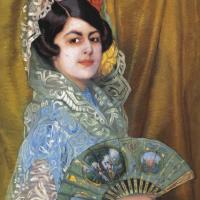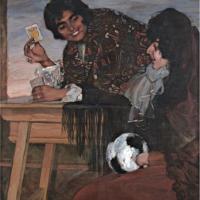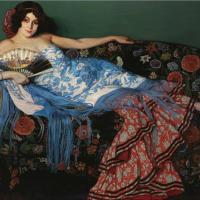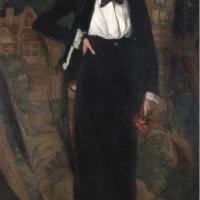Ignacio Zuloaga
Ignacio Zuloaga
Ignacio Zuloaga (1870-1945)
Ignacio Zuloaga and Zabaleta , born on June 20 , 1870 in Eibar , and died on October 31 , 1945 in Madrid , was one of the most important Spanish painters of the late xix th century and beginning of the xx th century .
His father was the remarkable damascene Plácido Zuloaga. As a child, he worked in his studio, where he began drawing and engraving . His schooling was done in France among the Jesuits ; he completed it at Madrid , Paris, and Rome .
In June 1895, he exhibited a series of six paintings entitled White Spain at Le Barc de Boutteville (Paris) .
In 1910, La Niña de los Peines was his model. But his favorite model was Agustina, the mother of the matador Ignacio Rafael García Escudero " Albaicín " .
Zuloaga was especially linked with Segovia , the city first, where for fifteen years and until 1913, he kept a studio where he spent the autumn, absorbed in an intense work which he took immediately to Paris production, but also with the province, and especially the medieval village of Pedraza , where he had to live and work in his castle, that of Los Velasco that he bought in 1925.
He was a great aficionado of bullfights , about whom he represented in his paintings, even scoring once to enter the arena.
Of an independent nature, Zuolaga did not adhere to any particular ideology and jealously guarded his independence. His friends were Camille Mauclair , Paul Fort , Maurice Barres , Charles Morice , José Ortega y Gasset , and Miguel de Unamuno . But after his stay in Paris where he resided until the beginning of the end of the First World War , Ghislaine Plessier notes a rapprochement with a nationalist ideology in the years 1920-1930 in particular in his correspondence with Émile Bernard.
The painting of Zuloaga was sometimes of the most discussed in Spain because of its raw and dramatic character. Table bull run Eve was rejected by the Spanish jury of the Universal Exhibition of 1900 . But The Victim of the fiesta was a great success at the Salon des artistes français in 1911, with a laudatory article by art historian Camille Mauclair . Among the most important bullfighters' portraits are those of his godson, Agustina's son, Albaicín, whom he had put in the habit of light when the young boy had not yet thought of being a bullfighter .
He is the author of the portrait of art collector Carlos de Beistegui . This portrait is on display in the Louvre , in the "Salle Beistegui" on the second floor of the Sully Pavilion; according to the wishes of its sponsor, this portrait must be permanently displayed in the important and indissociable collection of paintings of his donation to the Louvre. Zuloaga also appears in the Musée d'Orsay or in Castres.
The Portrait of the Countess Mathieu de Noailles , realized around 1913, is present in the book The 1001 pictures that must have been seen in her life ; critics Lucinda Hawksley describes it as "wonderfully decadent" .
In his hometown of Eibar , there is an institute that bears his name and where one can pass the baccalaureate and do a cycle of studies.







